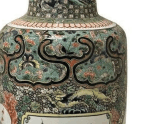Contemporary Exploration of Ceramics in Nigeria: Ngozi Omeje’s Connecting Deep Exhibition at the Centre for Contemporary Art, Lagos

he Center for Contemporary Art, Lagos (CCA, Lagos), presented an exhibition of nine giant elephants by Ngozi Omeje between September 6 and November 9, 2018. In this massive installation, eight elephant forms were grouped together while the ninth, and what seemed to be the lead elephant, occupied a space at the far corner of the display space and was, apparently, looking after the rest of the herd. Each elephant was installed by cleverly suspending pieces of terracotta from a mass of acrylic ropes and transparent fishing lines. The technology employed in Ngozi’s exploration immediately reminds one of such artists as Jae-Hyo Lee, Sean-GhiBahk and Augusto Esquivel, whose installations may have inspired Omeje at some point in her career. Jae-Hyo Lee and Sean GhiBahk are two Korean installation artists who also create three-dimensional forms by suspending units of rocks and charcoal respectively, with strings. Pinar (2012) acknowledges Lee’s ability to manipulate nature to arrive at something new without losing the essence of the materiality of his medium. By hanging units of stone in layers and creating contours and negative spaces, interesting tunnel-like forms are cleverly suspended in space. For Sean GhiBahk, pieces of charcoal suspended with nylon threads tries to examine the relationship between natural material (coal) and man-made objects such as pillars, tables, chairs, stair case, circles, and picture frames. According to Marie-Louise Lischnewski (2011), BahkSeonGhi’s sculptures, especially in his exhibition, illustrate “the intimate connection between becoming, being and decay” where “burnt organic matter like coal reminds Unlike the two Koreans who explore organic materials of stone and coal, the Argentine-born Augusto Esquivel is enthused by the colourful effects of pictures and forms created by suspending hundreds and thousands of simple sewing buttons with thread. He is not concerned with deep statements or probing, but is content with the exciting colour play in his simple themes of boxes, flowers, frames and portraits.
You’re reading a preview, subscribe to read more.
Start your free 30 days



